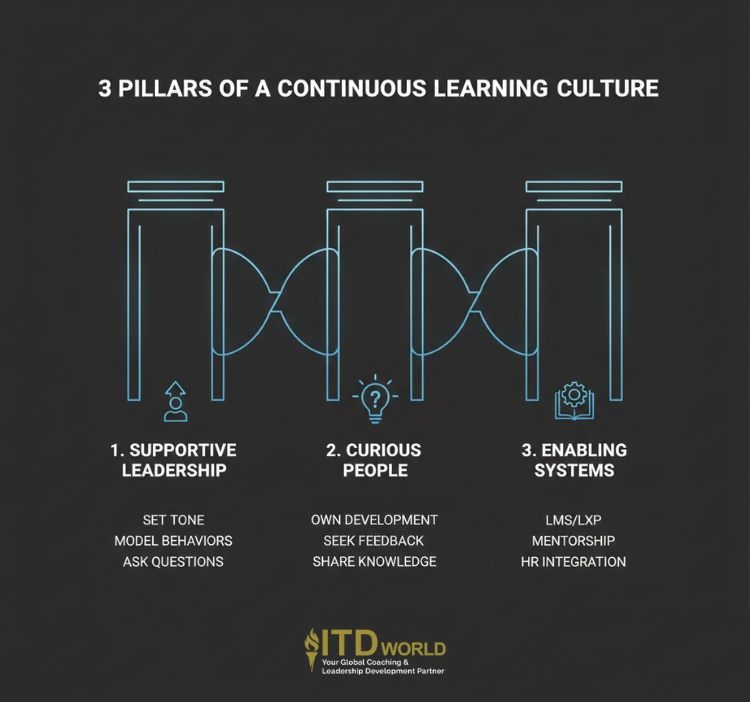A comprehensive framework for building a continuous learning culture, including core pillars, common barriers, and steps for implementation.
The pace of change is relentless in the current business landscape, driven by rapid advancements in AI, digital disruption, and constant market volatility. As such, the skills that guarantee success today may become obsolete tomorrow. In such an environment, the only truly sustainable competitive advantage is the ability for an organization to learn, adapt, and evolve faster than the competition – which is achieved not through sporadic training events, but by building a continuous learning culture.
(by Jonathan M. Pham)
Highlights
- A continuous learning culture is an organizational environment where learning, knowledge sharing, and innovation are fundamental, ongoing aspects of daily work, encouraged at all levels, and directly tied to individual and strategic goals.
- In today’s rapidly changing world, continuous learning in the workplace is crucial for organizational agility, innovation, and long-term survival, leading to increased profitability, and enhanced employee engagement and retention.
- A robust learning culture is built upon three interconnected pillars: supportive and learning-oriented leadership that models desired behaviors, empowered and curious people who take ownership of their development, and enabling systems and processes that integrate learning seamlessly into daily work.
- Fostering a learning culture requires a two-pronged approach: leaders must actively model curiosity, coach for development, and celebrate smart risks, while the organization provides personalized learning paths, diverse resources, workflow integration, and incentives for growth.
- Common challenges of establishing such a culture include the “no time” dilemma, budget constraints, and the fear of failure – all of which require strategic solutions such as integrating learning into daily work, leveraging internal resources, and fostering psychological safety.
- Measuring the impact of a continuous learning culture involves tracking leading indicators like participation rates, learning platform usage, and employee feedback, along with lagging indicators such as internal promotion rates, talent retention, innovation speed, and overall business performance, to justify investment and guide strategic direction.
What is a Continuous Learning Culture?
A continuous learning culture is an environment where learning is seamlessly integrated into the daily work, values, and mindset of an entire organization. It marks a fundamental shift away from viewing training as a sporadic, formal event. Instead, it creates a state where team members at all levels are actively encouraged, empowered, and expected to learn, share knowledge, and innovate as a core function of their job.
Key characteristics:
- Curiosity is championed: Questions like “Why do we do it this way?” or “What if we tried…?” are encouraged and rewarded, not seen as a challenge to authority. There is a collective desire to explore and improve.
- Psychological safety is high: Employees feel safe to admit “I don’t know,” raise concerns, share nascent ideas, and make mistakes without fear of blame or reprisal.
- Knowledge sharing is seamless: Information flows freely across teams and departments rather than being hoarded in silos. Successes and failures are both treated as learning opportunities for the entire organization.
- Learning is tied to goals: Learning is not just for personal enrichment; it is directly linked to both an individual’s career development goals and the overarching strategic objectives of the organization.
Example of A Learning Culture in Action
To understand the difference, let us consider how two different cultures might react after a project misses a major deadline. In a traditional one, the focus is likely on assigning blame. Team members may hide information to protect themselves, and the primary outcome is often a report that identifies who was at fault.
On the other hand, in a continuous learning culture, the team would conduct a “blameless post-mortem” or an “after-action review.” The leader would facilitate a discussion focused not on “Who was responsible?” but on something like: “What did we plan to do? What actually happened? What did we learn from the gap between the two? And what will we do differently on the next project?” As a result, failures are transformed into collective learning assets that make the entire organization stronger.

The Importance of Continuous Learning in the Workplace
We are living in a volatile, uncertain, complex, and ambiguous (VUCA) world where the half-life of professional competencies is shrinking dramatically. The World Economic Forum’s research has consistently highlighted this trend, with recent reports estimating that a significant percentage of core skills will be disrupted in the next five years, largely due to rapid advancements in AI and automation. In such an environment, the ability of a workforce to unlearn, relearn, and adapt is the single most critical factor for organizational agility and long-term survival.
Benefits of continuous learning in the workplace:
- Increased innovation & agility: A study by McKinsey found that companies with effective talent and learning strategies are more likely to outperform their peers in creating new products and services. When individuals are constantly learning, they are better equipped to connect diverse ideas and pivot quickly in response to market changes.
- Enhanced employee engagement & retention: In the ongoing war for talent, development opportunities are a key differentiator. Linkedin’s Workplace Learning Report consistently finds that organizations with high internal mobility – a direct result of upskilling and a learning culture – retain employees for significantly longer. When companies invest in their people’s growth, their people invest their loyalty in return.
- Improved performance & profitability: Research has shown that organizations that are recognized as leaders in learning and development tend to report higher profit margins and revenue per employee than their competitors.

Leading global companies have been treating learning not as a cost center, but as a strategic investment in their future. An example is IBM – which, facing massive industry shifts, has invested heavily in creating a proactive learning culture. Through its AI-powered learning platforms and a commitment to providing employees with extensive development opportunities, the company has successfully upskilled its workforce in critical areas like AI, hybrid cloud, and cybersecurity, directly enabling its business transformation and market leadership.
While a learning culture is indeed important for all organizations, it is an absolute necessity for survival in certain fast-moving sectors, namely:
- Healthcare: New medical research, treatments, and technologies emerge constantly. Continuous updating their knowledge is a fundamental requirement for medical professionals to ensure patient safety and quality of care.
- Information Technology: The rapid evolution of software languages, cybersecurity threats, and cloud infrastructure means that skills can become outdated in as little as 18-24 months. Continuous learning is, therefore, essential for maintaining professional relevance and organizational security.
- etc.
3 Pillars of a Continuous Learning Culture
A successful continuous learning culture needs to be intentionally built upon a solid foundation of three distinct but highly interconnected pillars. When these elements are strong and aligned, they work together to create a powerful, self-reinforcing ecosystem where growth and improvement become the natural way of doing business.
-
Supportive & learning-oriented leadership
Leaders at all levels must actively champion and model the desired behaviors. They set the tone for their teams and the wider organization, and without their buy-in, any learning initiative is destined to fail.
What it looks like: Instead of pretending to have all the answers, a leader should frequently ask, “What can we learn from this?” or “What’s a new approach we could try here?” They openly share their own learning journey and mistakes – as well as create psychological safety by celebrating their team members’ efforts to cultivate new skills, not just their successful outcomes.
Read more: Humble Leadership – The Quiet, Often Forgotten Powerhouse
-
Empowered & curious people
A learning culture cannot be a purely top-down mandate; it must be embraced by the employees themselves. This pillar represents a workforce where individuals feel a sense of ownership over their own development and are intrinsically motivated to learn and grow.
What it looks like: In such an environment, people feel comfortable and encouraged to block out time on their calendar for a webinar or online course, without fear of being seen as “not working.” They actively seek feedback on their performance, have clear professional goals, and feel inclined to share their knowledge with their colleagues.
-
Enabling systems & processes
The organizational infrastructure – the formal tools, resources, and processes – should be designed in a way that makes continuous learning easy, accessible, and integrated into the daily workflow.
What it looks like:
- Having a user-friendly Learning Management System (LMS) or Learning Experience Platform (LXP) with a wide range of on-demand courses.
- Establishing formal mentorship and coaching programs.
- Integrating learning into core HR processes, such as making progress on development goals a key part of the formal performance review cycle.
Read more: High-performance Culture – A Blueprint for Driving Excellence

How to Foster a Continuous Learning Culture
Building a continuous learning culture requires a deliberate, two-pronged approach. It is brought to life through the daily actions of leaders who champion curiosity and growth – and sustained by the organizational systems that make learning accessible, valued, and integrated into the fabric of the company.
The leader’s role: Primary catalysts
- Model insatiable curiosity
Leaders must be the chief learners on their teams. By openly admitting that they don’t know something and actively asks questions, they essentially give the entire team permission to embrace a curious, dare-to-fail mindset.
How-to: One may start their weekly team meetings with a “What I’ve Learned This Week” segment, briefly sharing an insight from an article, a podcast, or even an error they made.
- Coach for development, not just for performance
Shift one-on-one meetings from being simple status updates to being powerful developmental conversations – where the focus is on the team member’s growth as much as on the project’s progress.
Example: Instead of only saying, “Are you on track with the project?”, a learning-oriented leader may utilize coaching questions like, “What’s the biggest challenge you’re facing on this project, and what are you learning from it?” or “What new skill are you hoping to build through this assignment?”
- Celebrate smart risks and “noble failures”
To encourage innovation, leaders must create psychological safety around experimentation. In other words, they need to celebrate the effort and learning that come from a well-intentioned attempt, even if it doesn’t succeed.
Example: When a team’s experimental new feature doesn’t get customer traction, a supportive leader publicly praises the team for their innovative approach and the data they gathered, framing the outcome not as a failure, but as a successful test that taught the organization what customers don’t want.
Read more: Compassionate Leadership – Beyond Simply ‘Being Nice’

The role of leadership in cultivating a learning culture in the workplace
The organization’s role: Providing the infrastructure
- Provide personalized learning paths
One-size-fits-all training is likely to end up ineffective. A modern approach starts with a Training Needs Analysis (TNA) to identify the skill gaps relevant to the organization’s strategic goals. Based on the results, the organization may be better equipped to provide tailored learning opportunities for different teams and individuals.
- Build a diverse learning ecosystem
People learn in different ways. Therefore, a holistic strategy should ensure a rich blend of resources to suit these varying styles and needs. This means offering a mix of formal workshops, one-on-one coaching, group mentoring programs, and access to a comprehensive library of on-demand digital courses through a Learning Management System (LMS) or Learning Experience Platform (LXP).
- Integrate learning into the daily workflow
The idea here is to make learning a seamless part of the job, not a separate activity that people feel they “don’t have time for.” For this purpose, organizations may consider formally encouraging “learning on the job” through stretch assignments, creating peer-to-peer knowledge-sharing forums (e.g., a “lunch and learn” series), and dedicating a few minutes during team meetings for members to share key insights.
- Incentivize & recognize growth
The company must send a clear signal that learning and development are truly valued. This is best achieved by linking them directly to career progression.
How-to: Formally include progress on development goals as a key component of performance reviews, and explicitly tie the acquisition of new, critical skills to opportunities for promotion.
Read more: 10 L&D Trends to Help Your Workforce Thrive

Challenges of Creating a Continuous Learning Culture
While the benefits of a continuous learning culture are clear, the path to building one is not without its problems. Even with the best intentions, organizations are likely to encounter a set of barriers that can stall momentum and hinder progress.
- The “no time” dilemma
Indeed, this one is the most frequently cited obstacle. Employees and their managers are so focused on meeting immediate deadlines and operational demands that they feel they simply do not have time to step away from their work to learn. Learning gets pushed to the bottom of the priority list.
Solution: The key is to reframe learning from a separate, time-consuming event into a more integrated and efficient process.
-
- For leaders: Actively schedule and protect time for learning. This could mean dedicating Friday afternoons to development activities, or establishing “No-meetings” blocks of time where team members are encouraged to focus on online courses or deep work. By putting learning on the calendar, leaders signal that it is a legitimate and important part of the job.
- For organizations: Promote micro-learning – i.e. offering short, bite-sized learning content (e.g. 5-10 minute videos, quick articles, or app-based modules) that can be easily consumed during a short break, making learning more accessible for busy schedules.
- The budget constraint
There is a common perception that building a robust learning culture requires a massive financial investment in expensive platforms, external trainers, and formal programs, which may not seem feasible.
Solution: While strategic investment is important, many of the most powerful learning opportunities are low-cost or free. The focus should be on resourcefulness and the return on investment (ROI).
How-to: Leverage your greatest internal asset – your own people. Create peer-to-peer mentoring programs and encourage employee-led “Lunch & Learn” sessions to share internal expertise. When seeking a budget for training, frame the investment around the high cost of not training, such as the cost of employee turnover due to skill gaps or the business risk of becoming technologically obsolete.
Read more: Train the Trainer Model – Investing in Excellence
- The fear of failure
This refers to the deep-seated cultural issue where employees are afraid to try new things, ask questions, or admit they don’t know something for fear of looking incompetent or being penalized for making a mistake. Such fear is the single greatest enemy of learning.
Solution: The problem can only be dismantled when leadership actively and consistently promotes psychological safety. More than simply saying “It’s okay to fail”, they need to publicly discuss their own mistakes and what they learned from them – as well as to celebrate not just successful outcomes but also “Noble failures” (i.e. well-intentioned experiments that resulted in valuable data). When a leader’s response to an unexpected result is “Thank you for trying that. What did we learn?” instead of “Who is to blame?”, it creates the safety needed for real learning and innovation to occur.
Read more: Gratitude in the Workplace – A Reflection on Its Miraculous Power

Measuring the Impact of Your Learning Culture
To justify the ongoing investment in a continuous learning culture (as well as to guide its strategic direction), organizations must be able to measure its impact. While something like “culture” may seem abstract, its effects are tangible and can be tracked through a balanced scorecard of metrics.
Leading indicators
These involve forward-looking metrics that measure the health and adoption of your learning initiatives. They tell you if your employees are actively participating in the culture you are trying to build.
- Participation & completion rates: This goes beyond mandatory training. A key sign of a healthy learning culture is high voluntary participation in optional programs.
How to measure: Track the enrollment and completion rates for optional webinars, workshops, and mentorship programs. A high level of engagement here is likely to indicate intrinsic motivation.
- Learning platform usage: For organizations with a Learning Management System (LMS) or Learning Experience Platform (LXP), this provides a wealth of data.
How to measure: Monitor key metrics like the number of monthly active users, the most popular courses, and the average time spent learning per individual.
- Employee feedback on growth opportunities: Directly ask your team members to share how they feel about the learning environment.
How to measure: Incorporate specific questions into your regular employee engagement surveys, asking them to rate their satisfaction with the company’s support for their personal and professional development.
Read more: Continuous Feedback – A Cornerstone of Modern Workplace
Lagging indicators
Lagging indicators are the outcome-focused metrics that connect your culture to tangible business results, proving its return on investment (ROI).
- Internal promotion rates: A year-over-year increase in the percentage of leadership and key roles filled by internal candidates is a strong indicator that your programs are creating a robust succession pipeline.
- Employee engagement & retention: If people are learning and see a clear path for growth, they are far more likely to be committed and stay with the company.
Example: Correlate the retention rates of employees who actively participate in learning programs versus those who do not. A significantly higher rate in the learning group should demonstrate a clear ROI.
- Speed of innovation and problem-solving: A learning culture directly fuels agility.
How to measure: Track metrics like the time it takes to bring a new product or feature to market, or improvements in team productivity on complex projects. A faster cycle time is likely to be a direct result of a more skilled and collaborative workforce.
- Performance on key business metrics: The ultimate measure is the impact on the bottom line. Organizations should look for correlations between the teams with the highest learning engagement and their performance on core business KPIs, such as sales growth, customer satisfaction scores (CSAT), or operational efficiency.

Workplace Learning Quotes
Check out more learning and development quotes here!
The only thing worse than training your employees and having them leave is not training them and having them stay.
Henry Ford
An organization’s ability to learn, and translate that learning into action rapidly, is the ultimate competitive advantage.
Jack Welch, former CEO of GE
Train people well enough so they can leave, treat them well enough so they don’t want to.
Richard Branson
Learning is not attained by chance, it must be sought for with ardor and attended to with diligence.
Abigail Adams
The growth and development of people is the highest calling of leadership.
Harvey S. Firestone
Continuous learning is the minimum requirement for success in any field.
The most effective, successful professionals are constantly learning, they take the time to apply what they have learned, and they continually work to improve themselves.
Joel Gardner
Learning is a process, not an event.
Elliott Masie
The best development programs change the way people see themselves.
John Bright
If you want people to have fun, give them the day off. If you want them to learn, create engaging instruction.
Karl Kapp
Books About Workplace Learning
- Workplace Learning: How to Build a Culture of Continuous Employee Development by Nigel Paine: A practical guide for creating a learning culture that’s embedded in daily work, not just formal training. It includes case studies from companies like Microsoft and PwC, and offers strategies for using technology and measuring success.
- The Six Disciplines of Breakthrough Learning by Roy V. H. Pollock, Andy Jefferson, and Calhoun W. Wick: Introduces a results-driven framework for corporate training, emphasizing business outcomes and post-training reinforcement.
- Design Thinking for Training and Development by Sharon Boller and Laura Fletcher: Applies design thinking principles to learning programs, so that L&D professionals may better deliver learner-centered, engaging experiences.
- Training & Development For Dummies by Elaine Biech: A beginner-friendly, comprehensive guide that covers everything from designing training to evaluating its effectiveness.
- Telling Ain’t Training by Harold D. Stolovitch and Erica J. Keeps: A witty, research-backed book that challenges traditional training methods and presents practical alternatives for adult learning.
- Make It Stick: The Science of Successful Learning by Peter C. Brown, Henry L. Roediger III, and Mark A. McDaniel: Explores cognitive science behind how people learn and retain information.
- Map It by Cathy Moore: Focuses on action mapping – a visual approach to designing training that targets real workplace performance issues.
- The Art and Science of Training by Elaine Biech: Balances the creative and analytical sides of training, with tips on customizing learning to different audiences and situations.
- Bridging the Soft Skills Gap by Bruce Tulgan: Offers strategies for teaching essential interpersonal skills to younger employees.
- Employee Training & Development by Raymond Noe: A widely used textbook that covers the theory and application of training in organizations, including needs assessment and learning strategies.

Build a Sustainable Learning Culture With ITD World’s Solutions
At ITD World, we specialize in helping organizations design, build, and sustain thriving learning cultures that drive business results through our wide array of integrated solutions:
- Strategic diagnosis and planning: We partner with you to conduct a comprehensive training needs analysis (TNA), helping you identify the critical skill gaps and strategic priorities that will form the foundation of your learning roadmap.
- Customized training and upskilling programs: We design and deliver bespoke training programs to address your specific needs, whether it’s upskilling your workforce in emerging areas like AI and data literacy or strengthening timeless human-centric skills like leadership, communication, and collaboration.
- Building internal capability: Our world-class coaching and mentoring certification programs equip your own leaders and managers with the competencies to effectively develop your talent from within.
- Leadership development: We offer targeted programs designed to cultivate the supportive, learning-oriented leaders who are essential for championing and sustaining your culture for the long term.
Ready to future-proof your workforce and build a powerful, sustainable learning advantage? Contact ITD World today to learn more about how we can help you!
Other resources you might be interested in:
- Coaching Culture: A Blueprint for Organizational Growth
- Talent Transformation: Build a Future-ready Workforce
- 9 Key Leadership Skills for the Future of Work
- Employee Development Plan: Fueling Sustainable Success
- Resilience in the Workplace: Thriving in the Era of Crises

